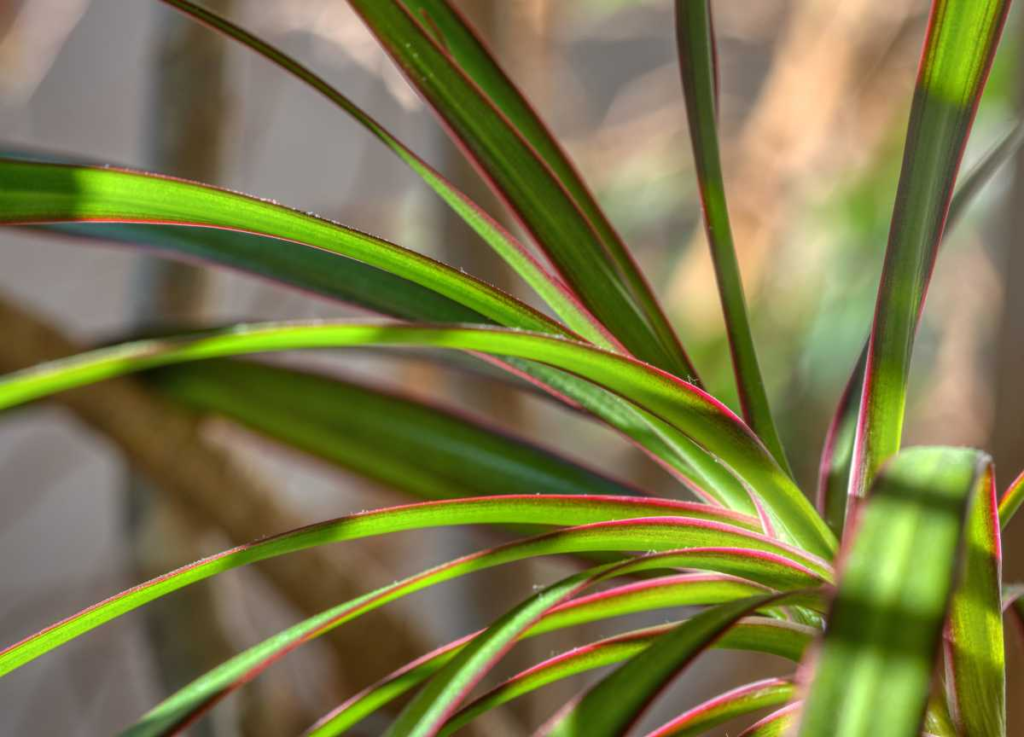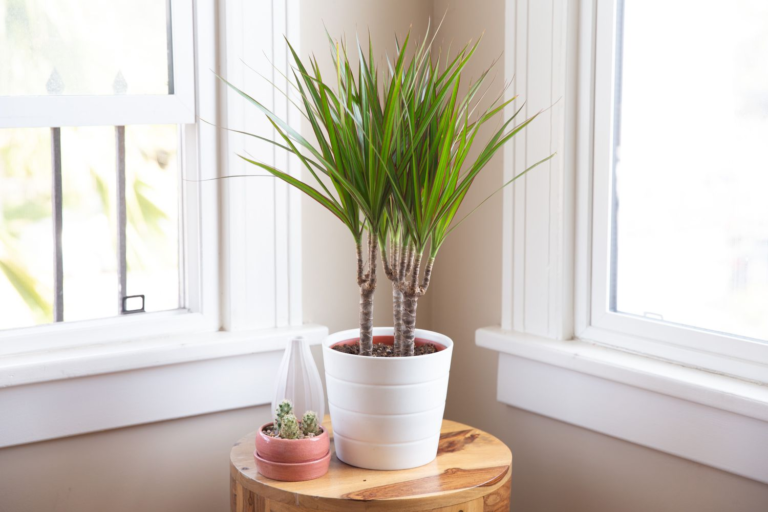The allure of houseplants is universal. They bring life, color, and a touch of nature into our homes, creating a serene and vibrant atmosphere. Among the vast array of houseplants, some stand out not just for their beauty but also for the stories they tell and the worlds they represent. One such plant is the Dracaena Marginata, commonly known as the Dragon Tree. Steeped in legend and hailing from the faraway shores of Madagascar, this mesmerizing tree captures the imagination with its sword-like leaves, tinged with an enigmatic shade of red. This guide will not only illuminate the care and keeping of this exotic beauty but also delve into its rich history, significance, and the many wonders it brings into a household.
Origins and Characteristics
Endemic to Madagascar, the Dragon Tree boasts green leaves edged in a striking red. Its visual appeal is undeniable. In the right outdoor conditions, this plant can reach heights up to 20 feet, but indoors, it’s typically maintained at a more manageable height of around 6 feet. Spring might bring forth white flowers, but indoor blooms are a rare spectacle. Pet owners should take heed: this tree is toxic if ingested by animals.
The Cultural Significance of the Dragon Tree
The Dragon Tree’s alluring aesthetics and robust nature have not just won the hearts of plant enthusiasts but have also cemented its place in various cultures and mythologies. In some tales, it’s believed that the Dragon Tree sprouted from the blood of dragons, making it a symbol of power and majesty. In ancient civilizations, the tree was often associated with wisdom, longevity, and protection. Today, it’s not uncommon to find the Dragon Tree in various forms of art and literature, symbolizing strength in adversity or the intertwining of the mystical and the mundane. Having such a storied plant gracing one’s space doesn’t just add beauty, but also a touch of folklore and legend, connecting us to tales as ancient as time.
Essential Dragon Tree Details: Quick Facts
| Feature | Detail |
| Common Names | Dragon tree, dragon plant, Madagascar dragon tree |
| Botanical Name | Dracaena marginata |
| Family | Asparagaceae |
| Type | Broadleaf evergreen |
| Mature Size | 15–20 ft. tall, 3–10 ft. wide |
| Preferred Sun | Full sun, partial shade |
| Soil Preferences | Loamy, well-drained |
| pH Level | Neutral to acidic |
| Flowering Time | Spring (less frequent indoors) |
| Flower Color | White |
| USDA Hardiness Zones | 10–12 |
| Native Areas | Madagascar |
| Toxicity | Harmful for cats and dogs |
Key Aspects of Dragon Tree Care
Light: Best suited for bright, indirect sunlight. Avoid exposing it to direct sun, as it can harm the foliage.
- Soil: Preferably, a blend of loamy soil mixed with peat moss. The potting medium must provide good drainage.
- Watering: Ensure the top half of the soil dries out between watering to avoid over-watering.
- Temperature and Humidity: Ideal temperatures lie between 70 and 80 degrees Fahrenheit. If your home is excessively dry, a light misting can benefit the plant.
- Fertilizer: This plant doesn’t require much fertilization. However, for those wanting a growth boost, a balanced liquid fertilizer in spring is suitable.
Varieties of the Dragon Tree
There are multiple varieties to choose from, each offering a unique appeal:
- Dracaena marginata ‘Tricolor’: Dark red margins, green leaves, and an ivory stripe down the center.
- D. marginata ‘Colorama’: Showcases a predominantly pink hue but with variegated white and green streaks.
- D. marginata ‘Bicolor’: As the name suggests, it features both red and green striping.
Pruning and Propagation
Dead leaves are a natural occurrence and can be easily removed. For a more manicured appearance, use sterile pruning shears to trim the plant.
Propagation is simple. Using stem cuttings placed in water is a straightforward method. Given the right conditions, roots will appear within weeks.
Repotting and Common Pests
Despite its slow growth, the Dragon Tree occasionally requires a larger pot. Repotting is generally needed only every two to three years. Refreshing the soil yearly helps the tree thrive.
However, the Dragon Tree is not invincible. Look out for pests like scale insects, mealybugs, and thrips.

Health Benefits and Environmental Contributions
The Dragon Tree isn’t just an ornamental gem; it’s an environmental warrior. Recognized by NASA’s clean air study, it can cleanse the air of harmful pollutants like benzene, formaldehyde, and trichloroethylene.
These toxins, often found in our homes due to materials like paints, solvents, and other household products, can have health implications over time. By absorbing these pollutants, Dragon Trees help create a healthier indoor environment. Moreover, by releasing oxygen, they also contribute to better air quality, which can enhance mood, concentration, and overall health.
Innovative Ways to Incorporate Dragon Trees in Home Design
When we think of houseplants, we often imagine them on windowsills or in corners, but the Dragon Tree’s versatility offers so much more. Its tall, slender trunk and cascading leaves make it perfect as a natural room divider. Placing a series of Dragon Trees in stylish pots can break up open spaces without blocking light, providing privacy and aesthetics. They can also be used to flank entrances, creating a grand entryway feel. For those with minimalist tastes, a single Dragon Tree can serve as a central piece in a room, drawing the eye and setting a calming, natural mood. As more homeowners and interior designers look for sustainable and organic elements in decor, the Dragon Tree emerges as a frontrunner, blending style with nature’s elegance.
Conclusion
The Dracaena Marginata, or Dragon Tree, is more than just a houseplant. It’s a statement of elegance, resilience, and a touch of exotic wilderness brought into our living spaces. Caring for it is not merely about maintaining a decorative element in your home; it’s about cultivating a relationship with a piece of nature’s artistry. By understanding its origins, needs, and characteristics, we not only ensure its thriving presence but also enrich our own lives with its silent, steadfast company. Embracing the Dragon Tree is a step towards embracing a world of botanical wonder where every leaf tells a story, and every growth rings in a new chapter of shared existence.
FAQs
1. What makes the Dragon Tree’s leaves have a red margin?
The red margin is a natural characteristic of the Dracaena Marginata. It adds to the plant’s unique appearance and is believed to provide added protection from the sun in its native habitat.
2. How often should I water my Dragon Tree?
The Dragon Tree is drought-tolerant. It’s recommended to water it when the top half of the soil feels dry. Overwatering can lead to root rot and other complications.
3. My Dragon Tree isn’t flowering. Is that normal?
Yes, it’s typical for Dragon Trees kept indoors not to flower. In their native habitat in Madagascar, they may produce small white flowers in spring, but this is rare when they are kept as houseplants.
4. I have pets. Should I be concerned about them with my Dragon Tree?
Dragon Trees are toxic when ingested, especially to cats and dogs. It’s essential to place the plant in an area where your pets cannot reach or nibble on it.
5. How do I propagate my Dragon Tree?
Dragon Trees can be propagated using stem cuttings rooted in water. Cut an 8-inch stem length, remove any leaves, and place it in water until roots form. After that, it can be potted in soil.
